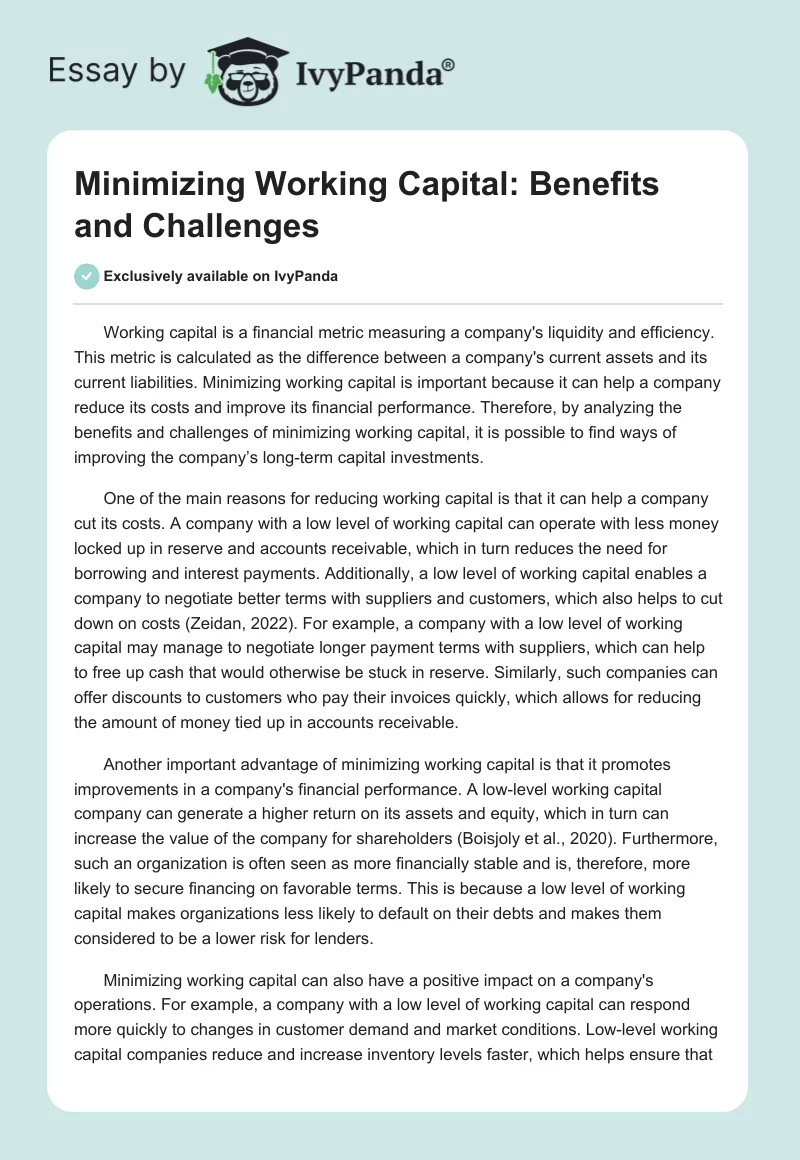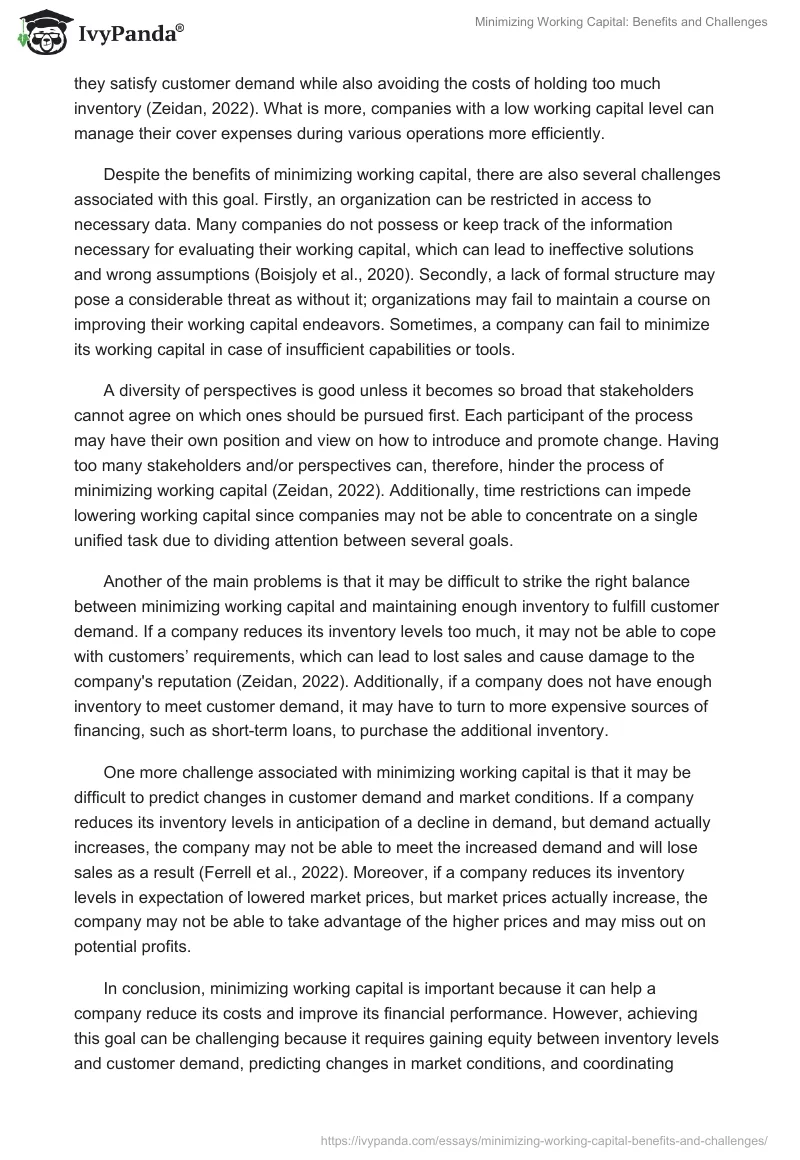Working capital is a financial metric measuring a company’s liquidity and efficiency. This metric is calculated as the difference between a company’s current assets and its current liabilities. Minimizing working capital is important because it can help a company reduce its costs and improve its financial performance. Therefore, by analyzing the benefits and challenges of minimizing working capital, it is possible to find ways of improving the company’s long-term capital investments.
One of the main reasons for reducing working capital is that it can help a company cut its costs. A company with a low level of working capital can operate with less money locked up in reserve and accounts receivable, which in turn reduces the need for borrowing and interest payments. Additionally, a low level of working capital enables a company to negotiate better terms with suppliers and customers, which also helps to cut down on costs (Zeidan, 2022). For example, a company with a low level of working capital may manage to negotiate longer payment terms with suppliers, which can help to free up cash that would otherwise be stuck in reserve. Similarly, such companies can offer discounts to customers who pay their invoices quickly, which allows for reducing the amount of money tied up in accounts receivable.
Another important advantage of minimizing working capital is that it promotes improvements in a company’s financial performance. A low-level working capital company can generate a higher return on its assets and equity, which in turn can increase the value of the company for shareholders (Boisjoly et al., 2020). Furthermore, such an organization is often seen as more financially stable and is, therefore, more likely to secure financing on favorable terms. This is because a low level of working capital makes organizations less likely to default on their debts and makes them considered to be a lower risk for lenders.
Minimizing working capital can also have a positive impact on a company’s operations. For example, a company with a low level of working capital can respond more quickly to changes in customer demand and market conditions. Low-level working capital companies reduce and increase inventory levels faster, which helps ensure that they satisfy customer demand while also avoiding the costs of holding too much inventory (Zeidan, 2022). What is more, companies with a low working capital level can manage their cover expenses during various operations more efficiently.
Despite the benefits of minimizing working capital, there are also several challenges associated with this goal. Firstly, an organization can be restricted in access to necessary data. Many companies do not possess or keep track of the information necessary for evaluating their working capital, which can lead to ineffective solutions and wrong assumptions (Boisjoly et al., 2020). Secondly, a lack of formal structure may pose a considerable threat as without it; organizations may fail to maintain a course on improving their working capital endeavors. Sometimes, a company can fail to minimize its working capital in case of insufficient capabilities or tools.
A diversity of perspectives is good unless it becomes so broad that stakeholders cannot agree on which ones should be pursued first. Each participant of the process may have their own position and view on how to introduce and promote change. Having too many stakeholders and/or perspectives can, therefore, hinder the process of minimizing working capital (Zeidan, 2022). Additionally, time restrictions can impede lowering working capital since companies may not be able to concentrate on a single unified task due to dividing attention between several goals.
Another of the main problems is that it may be difficult to strike the right balance between minimizing working capital and maintaining enough inventory to fulfill customer demand. If a company reduces its inventory levels too much, it may not be able to cope with customers’ requirements, which can lead to lost sales and cause damage to the company’s reputation (Zeidan, 2022). Additionally, if a company does not have enough inventory to meet customer demand, it may have to turn to more expensive sources of financing, such as short-term loans, to purchase the additional inventory.
One more challenge associated with minimizing working capital is that it may be difficult to predict changes in customer demand and market conditions. If a company reduces its inventory levels in anticipation of a decline in demand, but demand actually increases, the company may not be able to meet the increased demand and will lose sales as a result (Ferrell et al., 2022). Moreover, if a company reduces its inventory levels in expectation of lowered market prices, but market prices actually increase, the company may not be able to take advantage of the higher prices and may miss out on potential profits.
In conclusion, minimizing working capital is important because it can help a company reduce its costs and improve its financial performance. However, achieving this goal can be challenging because it requires gaining equity between inventory levels and customer demand, predicting changes in market conditions, and coordinating different departments. Companies should consider these challenges and develop strategies that will help them to minimize working capital in a sustainable way.
References
Boisjoly, R. P., Conine, T. E., Donald, M. B. (2020). Working capital management: Financial and valuation impacts. Journal of Business Research, 108, 1-8. Web.
Ferrell, O. C., Hartline, M. D., & Hochstein, B. W. (2022). Marketing strategy: Texts and cases (8th ed.). Cengage Learning.
Zeidan, R. (2022). The general model of working capital management. Palgrave Macmillan.


